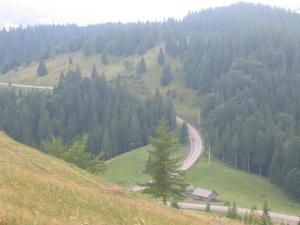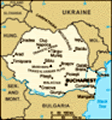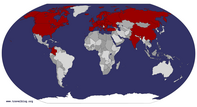Advertisement
Published: October 9th 2006

 1
1
Beautiful scenery in RomaniaHello everyone,
If someone asked me what stands out about my visit to Romania, it has to be Ceausescu Palace in Bucharest. It was built in the 1980's, but Ceausescu was executed when it was 70% finished. At 3,000 plus rooms, only the Pentagon is bigger. Some rooms are the size of a football field. There are 280 chandeliers; one weighs five tons. All 600 doors are solid wood, many elaborately carved. Ceausescu felt strongly about using only materials from Romania. He liked silk, but their climate doesn't lend itself to silk worms. So he built a lab for the sole purpose of creating silk for wall coverings and draperies. They could not give us a cost estimate for the building.
Ceausescu demolished entire neighbourhoods in Bucharest. He thought that they were old fashioned and a throwback to pre-communism. His master plan included having no old villages. He planned to demolish all the buildings and build one large highrise of flats in the middle. That way more of the land could be used for agriculture while the farmers lived in the highrise. All of Romania's rural traditions would have disappeared. If he had just ten more years, it would have

 2
2
People often keep a cow for milk in a back shed. They let them out in the morning and they walk to the pasture. At five they open the farm gate and the cow returns home. They are supposed to escort them, but why bother when the cow knows where she is going. Sometimes they have to walk through built up areas like this one.happened. Looking back, his trial for mass murder in 1989 probably wasn't a fair trial, but his execution made 22 million people very happy.
In 1947, the Communist Party on its first election. After that other political parties were eliminated. The king abdicated. All properties were nationalized. Political enemies and even those who caught thinking differently were eliminated. Aristocrates from the old system were at risk and could be charged in a kangaroo court of being "an enemy of the system." Forced labour camps existed between the Danube and the Black Sea. Our guide said that his grandfather kept a suitcase packed for three years because homeowners and small business owners could be considered "enemies of the state." As well, gold was a state monopoly. In the early days of communism, if you had gold--jewellry, etc., you were expected to turn it over the the state. They needed it and to not turn it over made you, you guessed it, "an enemy of the state." Things got easier after Stalin died in 1953. When Ceausescu was first elected in 1967, he was popular. He was considered a good guy by the west and received financial aid from the U.S.

 3
3
It is very rainy in the Transylvania region. Last year great sections of the highway washed away. It gave our bus driver some interesting challenges.He repaid his foreign debt, but the people paid dearly for this action. At first luxury goods disappeared--coffee, oranges, meat and cheese. Until the late eighties, supplies were limited. They had to stand in line for even basic items. Getting food was a family effort. It took every family member's co-operation to live with the monthly per person rationing of: ten eggs, one pound of meat and ten gallons of gas. Even with ration tickets, they still lined up before things ran out. Some days electricity would be shut down for a couple of days. Their concrete block buildings had central heat, but the heat would be shut down. They were told each year that next year would be better. As well, there was psychological oppression. The secret police infiltrated the general population. Even children were recruited to snitch on friends.
Under some circumstances passports were issued, but not to all family members at the same time.
One thing the communists didn't mess with was the education system. It was strong before. The teachers remained, although management changed.
In 1989 communism in Russia ended and the system started to fail in Hungary, Czech and Bulgaria. On December

 4
4
It is so rainy that farmers dry hay on these pyramids. See an empty structure in the foreground. If they just left it on the ground, it would never dry.17, 1989 demonstrations started, first in Bucharest and then in the rest of the country. Communism had to go. Ceausescu had to go. Many innocent lives were lost in the uprising. On December 25--only eight days later--Ceausescu and his wife were executed by firing squad. Why execute his wife? She had been named "second in command" by her husband and was too powerful to keep around.
The first free elections were held in 1990. A big focus since that time has been to meet the requirements of membership in NATO and E.U. They went through a period of high inflation during the early 90's so they had to keep issuing currency that was higher and higher. When things stabilized, they offered new currency that has the last four 0's removed. At this point there are both currencies in circulation. So to pay 20 lei for something I might hand over a 10 lei note along with a 100000 rom note.
Iron production was big in the communist days. "Steel" was the magic word. Factories were built and peasants worked free for the state.
Up to the 1940's people owned small tracts of agricultural land. After Communism

 5
5
This little guy made sure he was protected from the rain.became a reality, farming people were encouraged to join co-operative units. If they refused, a kangaroo court would impose penalties for any reason or actually no reason. So they "voluntarily" signed the papers. People continued to work the land, but saw little return. They had to turn over most of their production to the state.
They could keep a small garden and a few animals around their houses for their own use. Country life ws hard, but food wise, they were better off than people in big cities. The best combination was to have an apartment in the city, but have access to your parent's fruit and vegetables in the country.
After the fall of communism in the late 1980's, returning the land was more complicated that anyone would have thought. Just give it back to the original owners, right? The original owners from 1945 are dying off so there are numerous inheritance challenges. As well, there are problems about where lot lines, etc. are located. The process can take years through the court system to sort out. Our guide gave the example of his grandparents' apple orchard. It is in a neighbourhood where people have become accustomed

 6
6
Most of Romania's Jewish population came from Russia in 1800's. Many have now emigrated to Israel leaving a small poplulation. A fellow in our group could read Hebrew. He originally thought the hand holding the knife depicted a person who performed ritualistic slaughter, but upon reading the inscription discovered that they used this symbol for someone who was slaughtered 1914-18.to helping themselves to apples. His grandparents can't afford to put up a fence or hire a guard to protect their apples. As well, the orchard was not maintained for 50 years and they can't afford to get it back in shape. He said the family now has a place to get together for a family picnic once a year, but that is about it. Speaking of land ownership, generally therre is no planning or zoning. Subdivisions spring up and many have large homes. The homeowner is responsible for putting in a driveway and utilities, but they may find that there is no road to get home.
There is a large Gypsy population in Romania, but let's save that one until next blog.
Bye for now,
Donna
Transylvania has a large Hungarian population called Szekely. Way back they were free people, but their job was to support the cost of warfare--arms, food, horses, etc. If a family had five sons, then three of them would be warriors. During WWI the region of Transylvania was fought over by Romania and Hungary, but Romania won.
At one time, Romania had a large German population. In

 7
7
Regular cemeteries are very colourful.the 1980's Romanian citizens of German descent were allowed to get permanent passports. Germany had to pay Romania a great deal of money for every passport issued. Romania said that they had invested money in these people and should be compensated. About half the German population left. After the borders opened in 1990, many more Germans left--they thought the borders might close again. Their property had been nationalized forty years earlier, so they just abandoned their homes. The government gave the homes to poor people--mostly Roma. Now many villages in Romania have a definite German flavour, but are Roma communities.
During WWII Romania was a German ally, but in 1944 it switched sides and joined Russia.
Romania is to join the European Union next January. As with most countries, there have been some adjustments that the E.U. insists on. It is customary in Romania to slaughter a pig just before Christmas. Pork is the traditional dish of a Romanian Christmas feast and then they have meat for most of the winter. In the countryside, the pigs are raised in a sty behind the house and then the farmer kills the pig with a sharp knife to the throat.

 8
8
Traditional Romanian dress. This was handmade by her grandmother many years ago. The E.U. said that this isn't sanitary and insisted that they use an electrocution machine. Now Romania has been watching Hungary with great interest as they joined the E.U. a few years ago. When the E.U. insisted on this same electrocution machine for them, there were many casualties--not the pigs, the people trying to use the machine. I wonder if pigs can laugh. So someone in Romania came up with a novel idea to save this custom. They declared it a religious tradition, so the E.U. backed down. Speaking of religion, did you know that the Unitarian Church was founded in Romania? Romania has had freedom of religion since 1558.
Health care during the Communist period was corrupt. The whole philosophy of communism is equality and as a result doctors didn't earn much more than factory workers. It was customary to give an envelope with cash to a doctor in order to receive proper care. Since 1989 things are better--equipment and hygiene. Many doctors now have a private practice as well as earning a small salary at the hospital--but the envelope system is still used. People pay a percentage of their salary to a medical fund. Pensioners receive

 9
9
Pretty little village of Rimetea. A foundation is working to restore many of the existing buildings.subsidized medicine. Problem is that the subsidized meds run out three or four days after the first of the month, so they have to pay the regular going rate.
Advertisement
Tot: 0.379s; Tpl: 0.019s; cc: 13; qc: 71; dbt: 0.1545s; 1; m:domysql w:travelblog (10.17.0.13); sld: 1;
; mem: 1.2mb





















Marg Hambly
non-member comment
Romania
Wow! Your travel blog is so o o o informative. I bet you didn't gleen this much historical information from your school days. Sorry I am so late responding. I checked the email in a hurry and didn't respond and then promptly forgot to get back to it. Sounds llike you are having an amazing time, though- I really enjoy the pictures. Take care and keep in touch! Marg